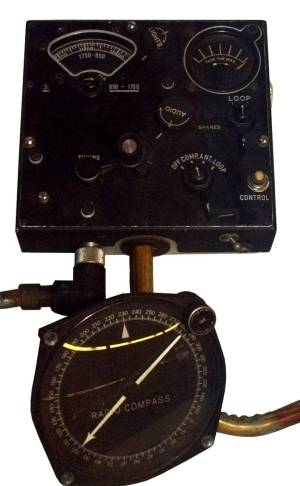Inhaltsverzeichnis
P-716: SCR-269 Radio Compass
Technical data
- Principle: automatic radio compass
- Frequency range: 200 - 1,750 kHz (three ranges)
Power supply
- Mains operation: (115 V)
- Batteries: 24 V, 12 V on-board power supply via converter MG-149-F
Dimensions
- Main unit BC-433-A: 200 x 305 x 500 mm, 21.25 kg
- BC-434-A control box: 190 x 190 x 94 mm, 1.7 kg
Components / accessories
- Main unit BC-433-A
- Control Box BC-434-A, two
- Loop Antenna LP-21-A, housed in an elegant streamlined metal cabinet
- Display instrument I-81-A and I-82-A
- Relay BK-22-A
Station material
 The SCR-269 radio compass was used in aeroplanes for navigation, the weight of the entire system is 33.2 kg.
The SCR-269 radio compass was used in aeroplanes for navigation, the weight of the entire system is 33.2 kg.
When tuned to a (long wave) beacon of an airfield or a radio (broadcast) transmitter (medium wave) on a known frequency, the corresponding bearing is shown in the display instrument. The pilot flies in the direction with a course deviation of 0°; when flying over the transmitter, the display changes to 180°.
The system consists of the actual BC-433-A receiver, one or two BC-434-A control units, the motorised adjustable loop antenna in a streamlined radome and accessories.
Technical principle
Tube configuration
two VT66, one VT-74, four VT-86, one VT-87, two VT-93, one VT-94, one VT-96, one VT-105, two VT-109
Development
In 1942, the SCR-269 radio compass developed by Fairchild Electronics was introduced in the US Air Force.
Deployment
Emergency landings by B-24 Liberator bombers also made the technology of the radio compass known in Switzerland. After the end of the war, several systems were purchased; two complete systems (in order to be able to determine the location more precisely by double direction finding) were installed in each of the three Ju-52 aircraft, and two further systems in the Beechcraft C-45 of the Swiss national topography.
Eight SCR-269 G systems were thus procured after 1945.





